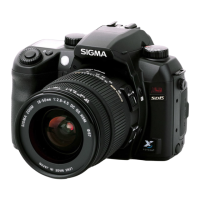
 Loading...
Loading...
Do you have a question about the Sigma SD15 and is the answer not in the manual?
| Camera Type | Interchangeable Lens SLR Type Digital Camera |
|---|---|
| Image Sensor Size | 13.8 x 20.7mm |
| Lenses Used | Sigma SA Mount Lenses |
| Picture Angle | Equivalent to 1.7x the focal length of a lens when used on a 35mm SLR camera. |
| Lens Mount | SA mount |
| Imaging Element Type | FOVEON® X3™ (CMOS) |
| Color Photo Detectors | 14.06 Million (2652 Columns x 1768 Rows x 3 Layers) |
| Image Recording Format | Lossless compression RAW Data (12bit), JEPG |
| White Balance | 8 Type (Auto, Sunlight, Shade, Overcast, Incandescent, Fluorescent, Flash, Custom white balance) |
| Viewfinder Type | Pentaprism SLR Viewfinder |
| Viewfinder Frame Coverage | 98% horizontal, 98% vertical |
| Viewfinder Magnification | 0.9x (50mm F1.4 at infinity) |
| Eyepoint | 18mm |
| Diopter Adjustment Range | -3dpt to +1.5dpt |
| Auto Focus Type | TTL phase difference detection system |
| AF Operating Range | EV 0 to 18 (ISO100) |
| Focus Mode | Single AF, Continuous AF (AF Predict function), MF |
| Metering Systems | Evaluative Metering, Center-Weighted Average Metering, Center Area Metering, Spot metering |
| Metering Range | EV 1 to 20 (with 50mm F1.4 at ISO100) |
| Exposure Modes | (P) Program AE、(A) Aperture Priority AE、 (S) Shutter Speed Priority AE、(M) Manual |
| ISO Sensivity | ISO (50), 100, 200, 400, 800, 1600, (3200) *( )Extended Mode |
| Exposure Compensation | ±3EV (in 1/3steps) |
| AE Lock | Push button type |
| Auto Bracketing | Three or five frames (in 1/3steps, Appropriate Exposure – Under Exposure – Over Exposure) |
| Shutter Type | Vertical-travel metal focal plane shutter, electronically controlled through entire speed range |
| Storage Media | SD Card / Compatible with SDHC, Multi Media Card |
| Aspect Ratio | 3:2 |
| Resolution | HI:2640 x 1760 MED:1872 x 1248, LOW:1312 x 880 |
| Interfaces | USB 2.0, Video Out (NTSC/PAL) |